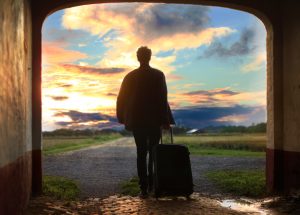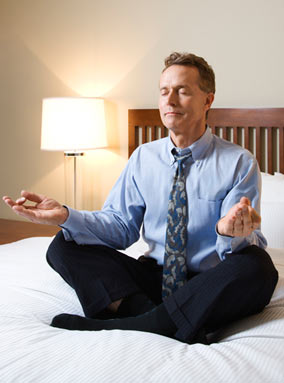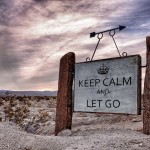
The experience of travelling to a new destination can be an exciting and wonderful opportunity to explore life. It can also be exhausting, stressful and time consuming.
In our busy lives, we can spend a lot of our time travelling. Whether it’s for work or pleasure, and whether it’s our daily commute or a long distance trip. Think about how much time you spend on the train, on the bus, in your car, on a flight, or walking from one place to another.
Here are some great travel meditation tips you can use to meditate while traveling. You can find the original article on wikiHow here.
Nine Travel Meditation Tips To Remember
A traveller doesn’t need to give up on meditation. In fact, being able to meditate as you travel can ease the little frustrations that occur with delays, queues, and unexpected obstacles that are a familiar part of the travel experience.

1. Be in the present moment.
[One] purpose of meditation is to ground you in the moment and to help you become more aware of your surroundings. When travelling, you’re already more aware of things around you because they’re new. Yet, you can’t possibly take in everything and the novelty itself can be a form of minor distress until you feel comfortable with it. Meditation can help you bridge the shock of the new with the comfort of enjoying learning about many new things and meeting new people. Meditation will also help you to be mindful of anything that you need to be paying more attention to during your travels.
2. Meditate when you’re a passenger.
Travelling on a bus, train, boat, or other form of transport can provide you with the opportunity to meditate as the journey meanders on. There are different approaches possible, including:
- Shut your eyes and concentrate only on the rhythm of the engine, wheels, tracks, etc. of the transport method. Use this rhythm to aid your meditation, focusing only on the particular rhythm and excluding all else.
- Count the number of cars you come across which are of a particular/favorite brand. Focus solely on seeing those cars that you have singled out for finding. Or count trees, signs, road markers, farmhouses, etc. Whatever you feel is the right object to follow.
- Close your eyes and count. Count each breath in and each breath out, from one to ten, then return to one again. If you lose your way or your mind drifts, start again from the beginning as you shouldn’t become out of touch with your breath and each count. This is a good way to while away the time of a long journey.
- Simply relax. If it’s a boat or train, and you’re able to move around, find a comfortable corner in the sun or somewhere with a pleasant ambiance and simply relax your whole body.
3. Meditate in your accommodation.
Your accommodation will undoubtedly vary from place to place and you will need to make the most of whatever you get. No matter how spartan, plush, or bizarre your surroundings, you should still be able to meditate. Focus on the moment, switch off all distractions such as the TV and cell phone, and find a comfortable part of your hotel room, dormitory, or other accommodation to meditate for a quarter hour or so each day.
- If you’re sharing a room, either select a time of day when it’s likely to be quiet or ask the concierge if there is somewhere quiet where you can go to meditate. Many people will be happy to accommodate your wishes.
4. Meditate while walking, hiking, or touring by foot.
“Walking meditation” [a type of ‘moving meditation‘] can be a useful method of meditating if you’re doing a lot of sightseeing or hiking as part of your travels. Walking meditation is a form of contemplative expression; use the time of walking to double check your posture (especially important if you’ve been wearing a heavy backpack or carrying bags). Walking meditation can also be an opportunity to relax from the inner complaints about feeling sore or tired from walking.
- Check your posture from head down to your toes.
- Walk with an awareness of each foot lifting up slowly, moving through the air, and taking the heel of one foot barely in front of the toes of the other foot.
- Keep the head and body trunk still.
- Keep your eyes looking ahead at the ground stretching out in front of you.
- Experience the changes occurring, ever so subtly, as you allow each foot to touch the ground, feeling the pressure exerted on the foot with each step taken.
- Allow the act of walking to be your full focus, rather than being preoccupied with the destination, or where you’ve been.
5. Meditate in nature. Many travel experiences include getting into natural environments, whether it’s a botanical garden, a sanctuary, a nature reserve, or a national park. Wherever there is nature surrounding you, you have an opportunity to meditate while contemplating the beauty of nature about you.
- Go out of your way to experience some nature while travelling. A journey to a new place is not complete without seeking out its natural aspects too.
- Feel the colors, hear the sounds, and enjoy the energy from nature as you’re amongst it.
- Relax and seek to be at one with the nature around you. Pay full attention to the natural elements that are contributing to your sense of well-being during your journey.
- Meditate on a flower. Flowers can be found anywhere, even in a hotel foyer. To meditate on a flower, look at the flower in great detail, with love. Take in every detail, color, and its totality. Notice any fragrance that it may have, and whether it is attracting other life, such as a bee, to it. Allow your attention on the flower to open up your experience of the wonders of existence.
6. Enjoy your new food experiences in a meditative way.
When travelling, you’ll often come across new foods that you haven’t tried before, or variations on foods you are used to. Not only does this offer a wonderful opportunity to open your mind to new experiences, tastes, and sensations, but there is a meditative opportunity here too. Pay attention to each and every ingredient of a dish. Can you name the particular ingredients?
- Eat slowly to enjoy the experience of eating – this will aid your digestion and help with peace of mind.
- Chew and swallow your food slowly and mindfully.
- Experience the different tastes from the food and drink.
- Use snacks as an entire meditation experience. For example, take a single raisin, or a slice of an orange, and turn it into an eating meditation. Become totally aware of the entire process of chewing it, feeling it on your teeth, tasting it on your taste buds, and swallowing it.
7. Listen as meditation.
When travelling, there are many sounds surrounding you, such as the rhythm of transport explored in an earlier step. Sounds can frustrate you if you’re over-tired and anxious but they can also serve as an anchor and ground you if you take them and meditate on them. For example, the sounds of flight announcements, the whirrs of jet engines, the hubbub of people talking, the music at a cafe, the drone of lawnmowers can all be sounds on which you choose to focus and notice your feelings as they rise and fall. Sounds document the ebb and flow of life, they are neither positive nor negative, and there are empty spaces in between them. Listen attentively and be receptive to how the sounds can provide meditation simply through the act of focused listening.
- Listen to a piece of music or a song. With portable music players, using music for meditative practices while you travel is extremely easy and can be done on any part of your journey. Pay attention to each note within the music, or to the instruments used, or to the words.
8. Visit meditation retreats.
It doesn’t matter if they are of your own faith or beliefs provided they welcome travelers or visitors with open arms and are happy for you to participate in their meditation practices. Look online for retreats near the locations where you’re traveling; most will make it amply clear if they accept transient visitors. Just be sure to conform to their rules and precepts, and to make a donation even if it’s not required.
9. Express gratitude.
As you travel, devote a part of your time to expressing your gratitude for your travel experiences.
- Be grateful for the people who have made your travelling experience much easier, more engaging, and eye-opening for you.
- Be grateful for the people who grew, harvested, and prepared the food you’re eating as you travel.
- Be grateful for the expertise of those who have transported you to all the different places you’ve been visiting.
- Be grateful for those who have hosted you in accommodation, enabling you to sleep and rejuvenate so far away from home.
- May all live in peace.
Content on wikiHow can be shared under a Creative Commons License.
Do you have any travel meditation tips to share?


